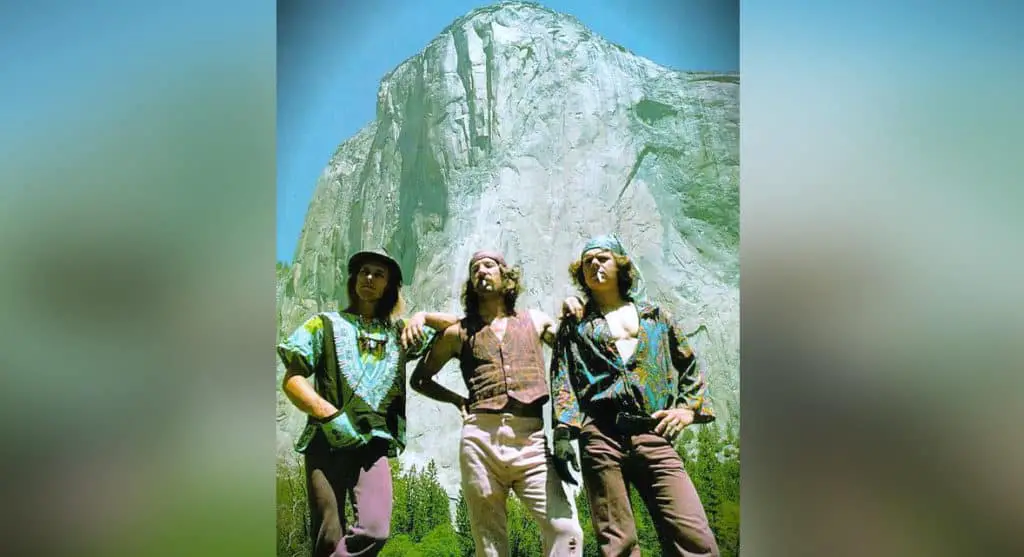
From daring free soloists, to impossibly strong athletes, to big wall legends, climbing has seen its share of icons throughout the years. This list contains my personal top ten climber ever — the legends who stand above the rest.
So, who’s the best climber of all time? The ten best climbers in history are:
- 10. John Bachar
- 9. Catherine Destivelle
- 8. John Long
- 7. Adam Ondra
- 6. Tommy Caldwell
- 5. Chris Sharma
- 4. Royal Robbins
- 3. Lynn Hill
- 2. Warren Harding
- 1. Jim Bridwell
Picking a ‘best’ climber of all time is difficult, because the technology, techniques, and training used have all evolved over time, meaning that modern climbers can climb much harder routes than their predecessors. Because of that, I’ve tried to take into consideration not only the difficulty of the routes climbed, but also the degree to which these climbers pushed the limits for their given generation. By doing so, I’ve created the above list of who I believe the greatest climbers of all time are.
Want to know who the best climbers alive today are? Check out my list here!
10: John Bachar
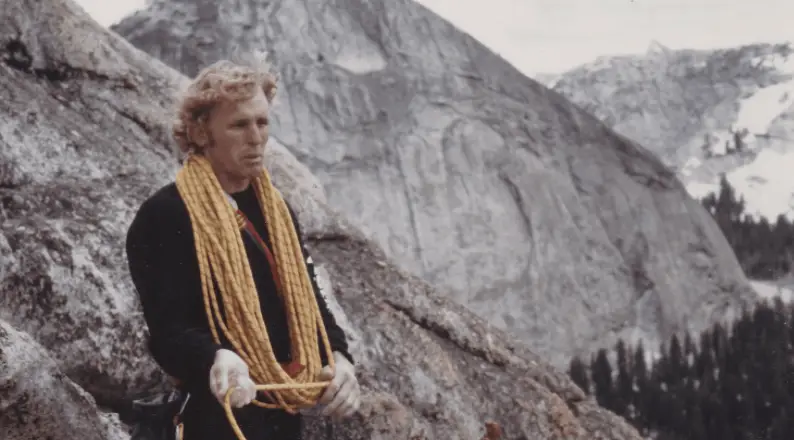
Known for his legendary free solo ascents that helped push climbing into the realm of mass popularity, John Bachar was a member of the infamous Stonemasters of Yosemite. During the 1960’s and 70’s, Bachar was one of the most well-known climbers in the world, renowned for his daring and challenging routes.
His resume is full of impressive accolades, including free solo climbs of Enterprise 5.12b and The Gift 5.12c, both of which were ground-breaking for their time (and still are to this day). Bachar was also a renowned free climber, and he was part of the team that first climbed Astroman 5.11c in Yosemite, which stands today as one of the most iconic climbs in the world.
Furthermore, Bachar was in large part responsible for the advent of many of the training techniques that are used today. He was one of the first athletes to use other exercises — like chin-ups and running — to train for climbing, rather than just going climbing more often (this technique, known as cross-training, has now gained mass popularity). He also invented the Bachar ladder, a brutal grip-and-core-training device that can be found in most climbing gyms.
9: Catherine Destivelle
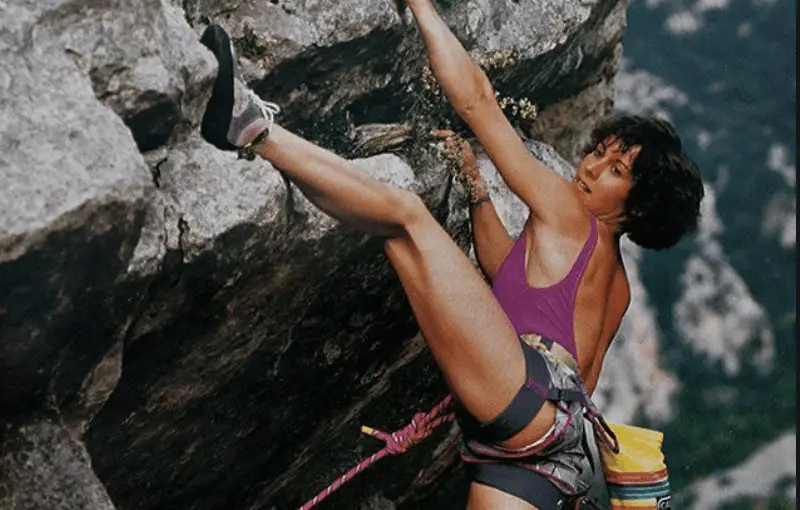
Catherine Destivelle is a famed rock climber, mountaineer, and alpine skier. What makes Destivelle so amazing — aside from her incredible climbing resume — is how multi-talented she was; she was able to be one of the best female climbers of her generation while also pursuing cutting edge alpine ascents and competing in ski mountaineering events.
Destivelle was the first woman to establish the grades of 7c+ and 8a+, along with being one of the first women to climb the grades of 7a, 7b+, and 8a. In addition to her red-point achievements, she has a lifetime’s worth of big wall climbs, including a free solo of the Devils Tower and her own route up the north face of the Eiger.
Additionally, Destivelle pushed the limits of alpinism and mountaineering to new heights. She has ascents of two 8,000-meter peaks, including Annapurna (the deadliest mountain in the world). She kept company with famed alpinist Jeff Lowe, reaching 5,800 on the unclimbed ridge of Latok 1 with him before being forced to turn around (that route remains uncompleted to this day.
As a rock climber, and as an all-around mountaineer and outdoor athlete, Catherine Destivelle is one of the greatest of all time.
8: John Long

John Long, the famed Yosemite climber and another member of the Stonemasters, was almost single-handed responsible for introducing the art of redpointing to the North American climbing scene. The massive influence that he had on the sport, combined with the sheer difficulty of some of his ascents, earns him a spot on this list.
Long was a close friend and climbing partner of John Bachar, for whom he actually introduced to free soloing. Once Bachar became known for that specific discipline, Long turned his attention towards redpointing — the art of working on a route from the ground up, taking several attempts and practicing specific sequences before finally climbing it in one go. Using this technique, he claimed the first ascents of Pasairo Overhang 5.12c and Hangover 5.13b, the latter of which was probably the hardest route in North America when it was established.
Finally, Long was a known big-wall climber. Like Bachar, he was part of the Astroman team, but that wasn’t even his crowning achievement; he also has the distinguishment of being one of the 3 climbers who scaled the Nose in day. That ascent, done on the most iconic climbing route in the world, stands today as one of the greatest achievements in the sport.
7: Adam Ondra
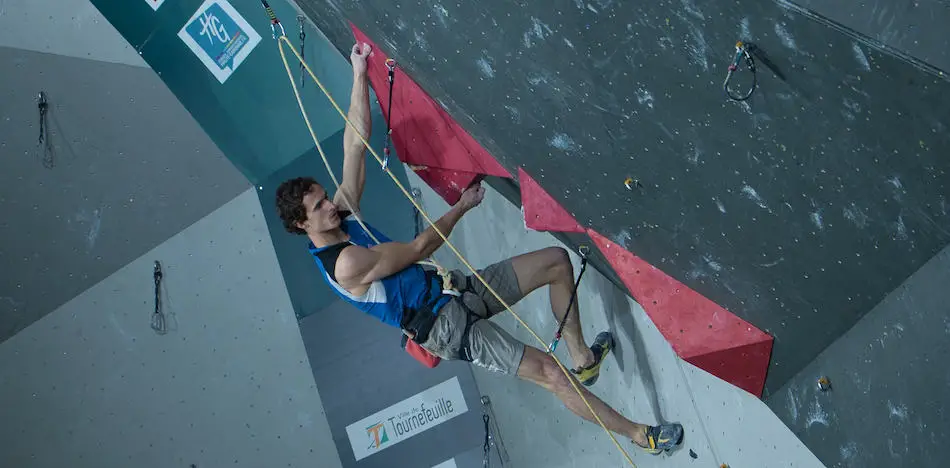
I talk a lot about how impressive Adam Ondra is. In fact, I believe that he’s the best climber alive today, and at 27 years old, he still has time to cement his legacy. As it stands, though, Ondra has already cracked the top 10 in terms of greatest of all time.
If there’s one thing that defines Adam Ondra, it’s how well-rounded his skillset are. While many climbers act as specialists, Adam does it all: he climbs sport routes, big walls, trad routes, off-width cracks, and incredibly hard boulders. What’s even more impressive is that he does it all at the highest level. A quick look at his resume immediately shows just how good Ondra is:
- First person to ever climb 5.15d
- First person to ever climb 5.15c
- First person to ever flash a 5.15a
- Most 5.15 ascents of any climber, ever
- Second ascent of Dawn Wall, 5.14d, 32 pitches
- Climbed Belly Full of Bad Berries, 5.13b, on his second attempt
- Has climbed multiple V16 boulder problems
- Has the hardest boulder flash ever with Jade V14
Despite being well-rounded, Ondra is a sport specialist at heart, and he dominates that area in a way that no one else has. Check out this graph below comparing his list of ascents versus some of the other best sport climbers in the world:
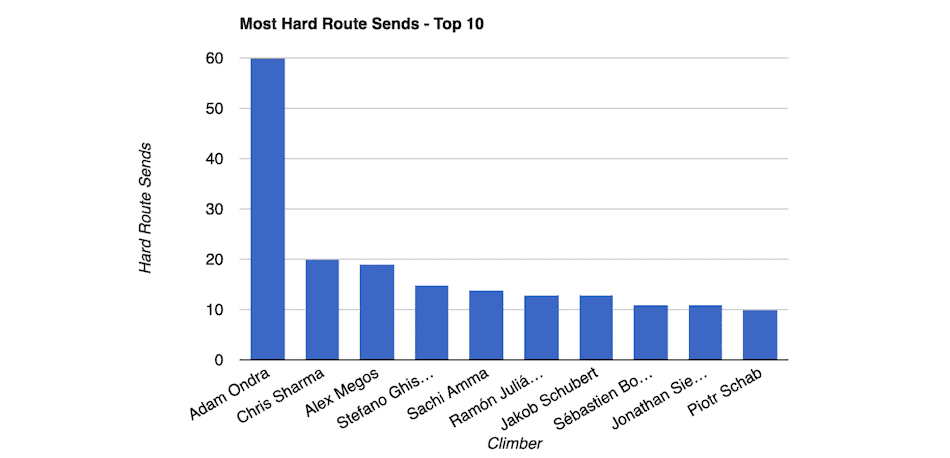
Credit: 99 Boulders (https://www.99boulders.com/hardest-sport-climbs)
As you can see, Ondra has as many hard sport climbs as the next three best sport climbers in the world, combined. That’s an insane level of dominance, and it just goes to show how Ondra is on a level of his own. Now, with more 5.15d’s to try, the Olympics looming on the horizon, and the sport of climbing becoming more popular than ever, Ondra has a chance to grow his legacy even farther.
6: Tommy Caldwell

Remember John Long, from two spots ago? Remember how he was a famed big wall climber? Well, Long himself dubbed Tommy Caldwell “the best big wall climber, ever”, and I have to say that I agree with him.
In the span of five years, Tommy Caldwell free climbed all of the available routes on El Capitan, which in itself was a monumental achievement (this included the second free climb of the Nose). Then, he began linking routes, climbing more than one in a day as an additional. Finally, when he got bored of that, he set 5 routes of his own, effectively doubling the number of free routes on El Cap.
Now, that alone is an insane resume, but that isn’t where it stops for Caldwell. He’s a noted speed climber, holding records for both the Nose and the Yosemite Triple Crown. Even more monumentally, he pioneered the only free route up the Dawn Wall, a 7-year project that saw Caldwell battle his way up 8 pitches of 5.14 climbing to establish the hardest big wall climb in the world.
What’s more, Caldwell isn’t just a specialist. He was the first ascensionist of Flex Luthor, a still-unrepeated line at the Fortress of Solitude that some have claimed could actually be as difficult as 5.15b. If that turned out to be true, that would give Caldwell the first-ever ascent of a 5.15b route, and it would propel him even farther into the rankings.
5: Chris Sharma

For a period of time in the early-to-mid 2000’s, Chris Sharma was climbing. Although he did have to share the spotlight with Caldwell for some of it, there was no doubt that Sharma was the undisputed king of the sport. His long hair, chill attitude, and explosive climbing style made him the perfect poster boy to help propel climbing into the mainstream.
He wasn’t just a pretty face, either. Sharma has pushed sport climbing farther than maybe anyone else with his ascents of Biographie, Jumbo Love, and Pachamama, which remain some of the hardest test piece 5.15’s in the world. He has the first ascents of both 5.15a and 5.15b, both of which put him in elite company. He also has 20 other 5.15 routes to his name, along with the hardest deep-water solos in the world with Alysha and Es Pontas
What’s even more impressive about Sharma, though, is how much he’s done from the sport. Every climber nowadays, from Adam Ondra to Alex Megos to Jonathan Siegrist, grew up with a Chris Sharma poster in their bedroom. Furthermore, several of the routes the these climbers now push themselves on — like La Dura Dura and Perfecto Mundo — were originally bolted by Sharma, and he was on hand to help out when those routes were first climbed.
Sharma’s power, perseverance, and willingness to push grades acted as an inspiration to up-and-comers, and a large part of climbing’s current popularity is owed to him.
4: Royal Robins
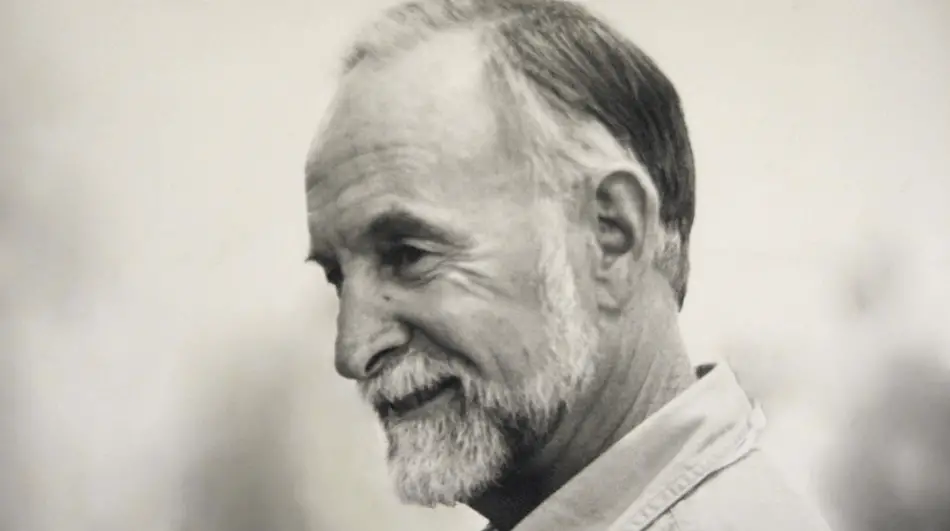
Royal Robbins is the grandfather of modern climbing, and much of the sport — from its recognition as a valid activity, to its ethics, to some of the most iconic routes in the world — are due to him.
Robbins was a career climber before climbing existed as a career. As a young man, he lived in the valley of Yosemite and helped to pioneer the early days of climbing in North America. Along with Yvon Chouinard — the famed founder of Patagonia — he is responsible for many of the ethics and leave-no-trace principles that guide climbing today.
More than that, though, he was a visionary climber who had the skill, discipline, and determination to tackle some of the largest walls in the world. He lead the first ascent of Yosemite’s Half Dome, one of the most iconic routes in the world. He also was the seconds person to ever climb the Nose — doing it in 7 days, when the first ascent took 18 months — and the second person to climb the Dawn Wall.
In a time when climbing hardly existed as a stand-alone activity, Royal helped to develop, grown, and push the sport to new heights, and that earns him the number four spot on this list.
3: Lynn Hill
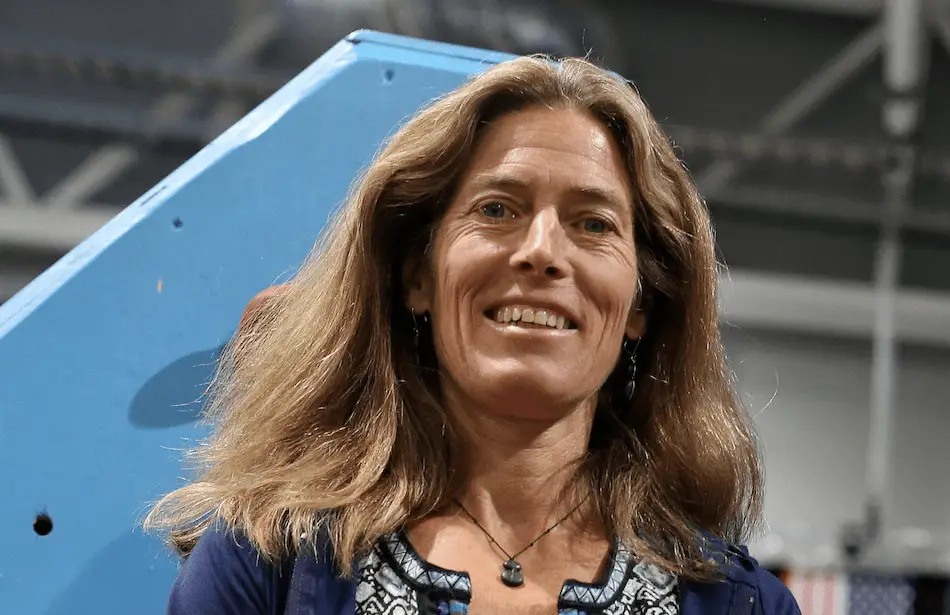
Simply calling Lynn Hill the best female climber would be a disservice to her incredible abilities and achievements. Hill is one of the best climbers in history, and her dominance over the sport spanned multiple decades and led to some of the most impressive ascents by any climber, ever.
At the start of her career, Hill made a name for herself in the testosterone-fuelled world of the Stonemasters. She was able to hang with — and exceed — other world-class climbers such as John Long and John Bachar on hard trad and aid ascents.
Later, once she left the Valley, she made a name for herself as a sport and competition climber. It was then that her rivalry with Catherine Destivelle really kicked off, and the two of them began to push each other to new heights. During this period, Hill claimed 30 world cup climbing titles and became the first woman to ever send a 5.14 route.
Those achievements alone would be enough to earn her a place on this list, but Hill wasn’t done. Later, after growing tired of the competition scene, she went back to Yosemite Valley and completely two of the most legendary ascents in climbing history: first becoming the first person to free climb the Nose, and then coming back a year later to do it again in a day. What it once took three Stonemasters to do, Hill was able to do on her own — and without needing any gear to help her.
2: Warren Harding
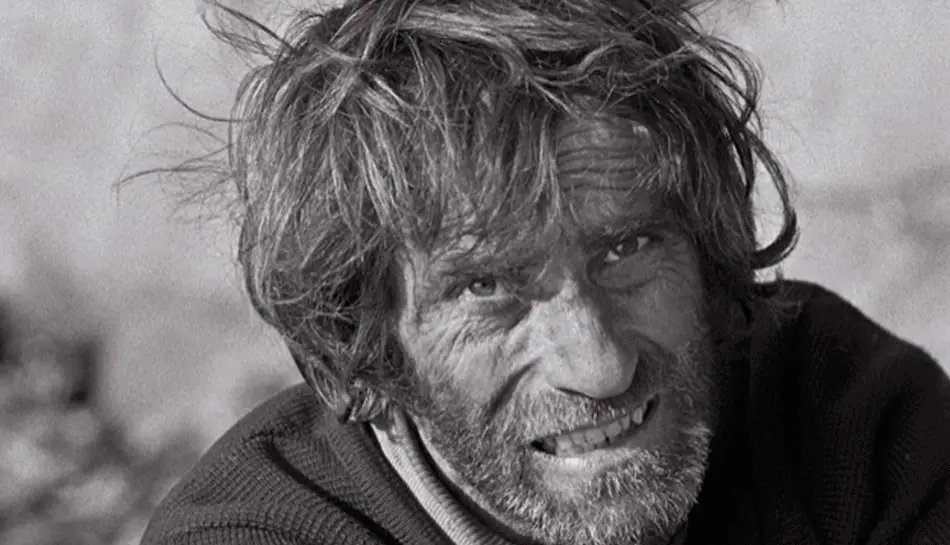
If Royal Robbins is the grandfather of modern climbing, Warren Harding is its alcoholic uncle. The two of them climbed during the same period, but they couldn’t have been more different: where Royal attempted to live his life as stoically as possible, establishing rules and ethics for climbing, Harding established the Lower Sierra Eating, Drinking, and Farcing Society as an excuse to chug wine and socialize with his friends on weekday nights.
Despite his questionable table manners, though, Harding was a monumental climber in his own right, and he set the two most important first ascents in the history of the sport: the Nose and the Dawn Wall, both of which Harding completed despite every other climber on the planet telling him that they were impossible.
Harding’s sheer willingness and determination to throw himself at projects — such as spending 18 months working on the Nose, or hanging from a sleeping bag for 23 days on the dawn wall — is what distinguished him from every other climber of his generation (including Royal Robbins), and it earns him the number two spot on this list.
1: Jim Bridwell

Coming in at number one, we have the coolest climber from the coolest generation of climbers to ever live: Jim Bridwell.
Bridwell’s career as a climber spanned two distinct eras of the sport’s history. As a young up-and-comer, he learned from the likes of Royal Robbins and Warren Harding, taking their knowledge and applying it on the massive granite walls of the Valley.
Later, he himself turned into the mentor figure, as he taught the likes of John Long, Lynn Hill, and John Bachar how to rock climb. In this way, Bridwell has had a larger impact on the climbing scene than maybe anyone else, as he helped to usher in the golden age of the Stonemasters.
He wasn’t just a teacher, though; Jim Bridwell was a masterful climber with a visionary’s ability to pick out a seemingly impossible line and establish a route on it. Most of his climbs were done before free climbing gained popularity, so his reign as Yosemite’s kingpin consisted of one insanely challenging aid climb after another, each of them pushing the limits of what was seen to be humanly possible.
Bridwell introduced the world to ‘do or die’ pitches and a style of climbing that demanded that you complete the pitch you’re on or risk your life in a fall. Some of these climbs — such as Sea of Dreams, Pacific Ocean Wall, and Zenyatta Mondatta — remain test pieces to this day.
Most famously, though, Bridwell lead the three-man team that climbed the Nose in a day, an ascent that stamped his name in the history books of climbing forever. Although he may not have the longest resume, or the most famous climbs, Bridwell was the catalyst that launched the golden age of rock climbing, and for that, I’m going to argue that he deserves to be recognized as the greatest climber of all time.
